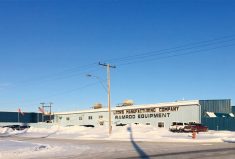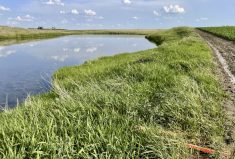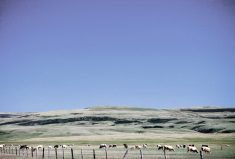Most people say, “If it’s not broke, don’t fix it.”
But at Hebert Grain Ventures, their motto is, “If it’s not broke, you haven’t looked hard enough.”
“We don’t believe that, just because we had a good year or a good yield, that’s enough,” said Evan Shout, the Saskatchewan farm’s chief financial officer.
“If we can cut costs and increase gross revenues just by looking at data analytics, we’re going to do that.”
By itself, the data being collected on farms today, although voluminous, is “essentially raw information — unusable in most cases, and not accurate in most cases,” Shout said at the recent AgSmart event at Olds College.
Read Also

Farming Smarter receives financial boost from Alberta government for potato research
Farming Smarter near Lethbridge got a boost to its research equipment, thanks to the Alberta government’s increase in funding for research associations.
Data analytics takes that data to the next level, turning it into something useful for making profitable decisions, he said.
At Hebert Grain Ventures, a 22,000-acre grain operation in southern Saskatchewan, they track and analyze everything — including financials, employees, and equipment in the field.
“All of this information is big data, but without actually putting it in an analytical form, you don’t get the usage from it,” he said.
Part of the problem for most farmers is the cost of new technology. But it’s a common misconception that farmers need to spend money on technology to make money off the data it could give them, said Shout.
“The No. 1 spot for data analytics is your own financial statements,” he said. “Everybody has to file a tax return. Everybody has financial statements from the bank. All of your decision-making for a year — capital expenditures, financing, when you’re going to buy inputs, when you’re going to sell — can be given to you by your historical financial statements.
“You don’t have to make a bunch of capital expenditures to get this information. Your financials will give you a good starting point.”
Data and people
But at Hebert Grain Ventures, their first focus is on their people.
“You wouldn’t think data analytics when you hear this, but… we have behaviour analysis done for every employee,” said Shout.
When a new worker is hired, they complete Myers-Briggs and Kolbe personality tests to determine their work styles, and then they fill out a list of their A (love it), B (don’t mind doing it), and C (hate it) tasks.
“You would think picking rocks would always be a C, but our best rock picker is our bookkeeper. She loves to get out of the office. She doesn’t want the stress of running a drill. So we put her on rock picking. Without those behaviour analyses, we would never have known what she wanted to do.”
There’s also a detailed employee handbook and training system detailing tasks, expectations, and policies and procedures.
While it “doesn’t sound like a big deal,” the system is key for landing and retaining good employees, he said.
“Losing a very valued employee can cost a business upwards of two times that salary. We want to retain people. So what do we do? We have pension plans, we have benefits packages, we have corporate trucks for longtime employees — anything to retain good help.”
From their data, they also know that 2,000 acres is the most one full-time employee can manage and that they’ll be paying 1.25 hours per acre. So if you’re running a 10,000-acre farm, for instance, you’ll need six full-time employees.
“That’s our sweet spot. We know those numbers because historically, that’s what’s been proven,” said Shout. “It’s just math. Our historicals have given us the data analytics to figure out our human resource issues.”
Equipment optimization
Hebert Grain Ventures has also cracked the code on making the most of its machinery.
“The biggest drag on farms right now is machinery, but new machinery is not the problem,” said Shout. “It’s actually about quantity, not quality. We’re looking for optimization, or utilization of the equipment we already have.”
For example, the amount of time that nozzles are running on the average sprayer in Western Canada is 37.5 per cent. That means when the keys are in the ignition, it’s sitting idle about 35 per cent of the time and in transport about 26 per cent of the time.
When Hebert Grain Ventures pulled its own data in 2017, they were sitting around 39 per cent.
“Once you know that number, it kind of scares you a little bit. So we tried to figure out ways to improve it,” he said.
“We didn’t go out and buy a new trailer — obviously, we weren’t using the one we already had. What we did was beef up our spray trailers.”
They hired a summer student to run the spray trailer and did batch fills with a stopwatch at every fill. As a result, the average fill time declined from 22 minutes to seven minutes.
“Last year, our (nozzles on) number went to 54.8 per cent. That’s not real good, but it’s an improvement,” he said. “All we did was beef up a spray trailer, and we improved 75 cents an acre. Seventy-five cents doesn’t seem like a lot, but that’s only one machine and one aspect.”
Input efficiencies
Crop inputs are another.
“We find that most producers do not farm the top 60 per cent of their fields very efficiently,” he said. “We’re very good at farming the whole field at an average, but we’re not very good at concentrating on our most productive 60 per cent.”
Shout knows that if the operation manages to get 100 per cent of the rainfall from their 30-year historic average, they can hit 86-bushel canola — and if they want to hit a mid-50-bushel-per-acre average, they will need to hit 86 bushels per acre on their top 60 per cent most productive land to account for the losses in the bottom 40 per cent of their fields.
But he also knows that three pounds of nitrogen are required for every bushel of canola, and if they want to grow 80 bushels on that top 60 per cent of the field, they’ll need 240 pounds of nitrogen. Assuming there’s a carry-over of about 20 pounds and 30 pounds of organic matter, they still need to apply 190 pounds of nitrogen.
“How many farmers put 190 pounds of N down? Not many.”
(That rate is achieved by top dressing and putting anhydrous down in the fall so it doesn’t sit directly with the seed.)
Last year, they bought soil moisture probes to maximize the limited moisture they were getting. At the time, the farm was sitting at about 40 per cent average rainfall, and every farm around them had parked their tractors — they weren’t about to waste money on top dressing when it was so dry. But based on the 30-year average, the probability of rain in the next month was quite high, and the new soil moisture probe showed there was still 11 inches of water in the ground.
“So what did we do? We went out and top dressed — 30 pounds of N across the farm. Everybody around us thought we were nuts,” said Shout.
The gamble paid off. Check strips produced 11 bushels an acre less than the rest of the field, and protein levels jumped from 12 to 13.9 per cent, earning them a premium.
“That means we received $1.25 a bushel more just based on protein across the whole 80 bushels an acre, plus we achieved 11 bushels per acre more than we would have,” said Shout.
“It cost us $15 for the N and $6 for the applicator fees — $21 an acre — but our net return was $162 an acre. It’s a seven-to-one return, all because of what the moisture probe told us.”
Making it work on your farm
For the average farmer (one who isn’t an accountant, as Shout is), all of this data analytics might sound overwhelming. Equipment can help, but only if the return on investment is clear.
“You can buy capital expenditures. You can buy the planter, you can buy the moisture probes, you can buy all this stuff, but it has to save you money in the long run.”
Beyond that, it can be hard to know where to start, said Shout.
His advice? Figure out where you want to be in five years, and work backwards from that to build a plan.
“Let’s say in five years, you want to run 24 hours a day — how did you get there? Well, you could implement shifts, offer overtime, focus on training, whatever,” he said.
“That’s what we did, and we were there in two years.”
Shout also suggests turning your advisers into unofficial partners.
“Stop treating your bank like you’re begging them for money. Make them your partner instead,” he said. “Lawyers, accountants — they’re not there just to write you bills. If you’re going to pay them, you might as well pay them for good advice. If all your accountant is doing is filing compliance forms, find a new accountant.”
And increasingly, large farms are relying on a board of directors or an advisory committee to help them make better decisions.
“In agriculture, we have this idea of ‘rugged individualism,” said Shout. “We’re really good at keeping things to ourselves. But we really need to get outside the box.
“I know everybody thinks they’re competing, but you don’t know what you don’t know, so talk to other farmers.”















